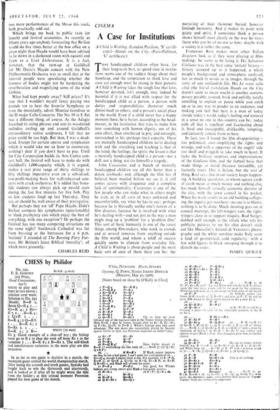CHESS by Philidor
No. 292. BLACK 64 men) F. E. GODFREY (xst Prize, Good Companions,
1917)
WHITE to play and mate in two moves ; solution next week. Solution to No. 291 (Booth). B—B threat Q—B 4. 1.. Kt—K 4 ; 2 Kt Kq.I . B—K 4 ; 2 QX P. I .
R—K 4 ; 2 Q—B 8. z . . . B—K 6 ; 2 B—Kt 1. I . . R--K 5 ; 2 R— WHITE (12 men) Kt 5. Good example of a shut-off key ; the bishop must go to B z to shut the rook off from Kt I in the variation z . . . B—K 6 ; 2 B—Kt I. The self-block and interferences variations in the main play are also attractive.
In so far as one game is decisive in a match, the twentieth game settled the world championship match. After losing the seventh and tenth games, Spassky had fought back to win the thirteenth and nineteenth, and it looked as if after all he might wrest the title from the holder ; at this critical moment Petrosian played his best game of the match. White, PETROS1AN Black, SPASSKY Opening, Q. PAWN, NIMZO INDIAN DEFENCE (Moscow, May 30, 1966) [Notes based on those by O'Kelly in Chess]
r P—Q 4 Kt—K B 3 a P—Q B 4 P—K 3 3 Kt—Q 83 B—Kt 5 4 P—K 3 0-0
5 B—Q 3 P—B 4
6 Kt—B 3 P—Q4 7 0-0 Kt—B 3 8 P—Q R3 BxKt 9 P xB Q Px P ro Bx.BP Q—B 2 11 B--Q 3 P—K 4
rz Q—B 2 B—Kt 5 Up to here we have followed one of the standard lines in the Nina° Indian Defence. Here R—K z may be better, though after 13 Kt x P, Kt x Kt; r4 PxKt, QxP; 16 P—B 3 White's bishops give him some advantage. The text move was successfully played by Spassky against Geller in 1956, but Petrosian improves on Geller's play.
13 Kt x P Kt x Kt 14 P x Kt Q x P .r5 P—B 3 B—Q z
26 P—Q R 4!• • Here Geller played t6 R—K z? overlooking the fine reply 16 ... B—R 5! (t7 Q xB?, QxBP1). VS.. . K R—K r If Black cannot improve he
on this, has a bad game. I can't quite see a refutation of a6 ... Kt—Q 4, tiler expect there is one. For example, 17 B x P ch,
K—R z; 18 K 4, QxQ; zg BxQ, Ktxlid P; ao BxP, Q R—Kt r, Black will recover his pawn. _ 17 P—K 4 P—B 5 Not good, but White's bishops and strong centre give Black a bad game, anyway. 18 B—K a18 B x P?, Q—B 4 ch.. ✓ 8 . . . .13.—.-K 3 19 B—K 3 Q—B 2 so Q R—Kt r Kt—Q 2
21 R—Kt s! P—Q Kt 3
12 R (B r)—Kt r Q-13 3 23 B-14 P—B 3
24 2: 2 K—R r 25 B r P—K R 3 26 P—R 3 Q R—Kt r
27 P—R s! R—Kt 2 27 • . . P—R 3; 28 R xP!, Kt x R; 29 P > Kt, and White will win the Q R P, where- upon the two extra pawns will he too good for the exchange. White has now built up rn advantage on both sides of the board.
28 P x P As O'Kelly points nut, better 28 R (5)--Kt ;CI.: h-13 r and now 29 P > P. As will be seen, WR would be much better placed on Kt 4 than Kt 5.
.28 . . . P :- P 29 Q—K B 2 R—R .t!
30 Q—Kt 2 • • • 3o B Y P?, R (r)—Q Kt r winning a piece—because of the vulnerable position of the R on Kt 5.
R ,Kt2)—R 2
37 BxKt P R—R 7
32 Q—Kt 4 R—Q B 7? 32 . . . R (R 7)—R 5!; 33 Q—K 7, R—Q Kt 1; 34 R (s)—Kt 2, R (5)—R 1! (threat 35 • • • R—K r; 36 (.1--Kt. a, R (Ic. r)--Q Kt t. with a draw by repetition of moves); 35 B—B 7, R—Kt 6! was correct and appears to give Black a draw. The champion gives him no further chance.
33 B—B 2 Q—B 2
34 Q—If! 8 :" P He can no longer defend himself, e.g. Ft (1)—R 7; 35 R—Kt 8 ch, K—R 2; 36 Q x B! and White wins (36 . . Kt x R; 37 B x P! with a winning attack or 36 . • . R xB; 37 Q—B 5 ch, P—Kt 3; 38 Q—Q 5).
35 Px.B R xB
36 K x R Q—R 7 ch This is all nothing.
38 37 B—Kt 2 Al—K R—Kt 8 ch R x R 4 39 RxRth K—R a 40 R—Q 8 Kt—Kt 3
41 42.7—K 6 Resigns 41 . . . Qx B ch; 42 K x B, Kt—B 5 ch; 43 K—Kt 3, Kt x Q; 44 R—Q II x wins easily. An impressive game, iustly greeted with shouts of 'Time/ Tigran l' from the champion's supporters.






































 Previous page
Previous page